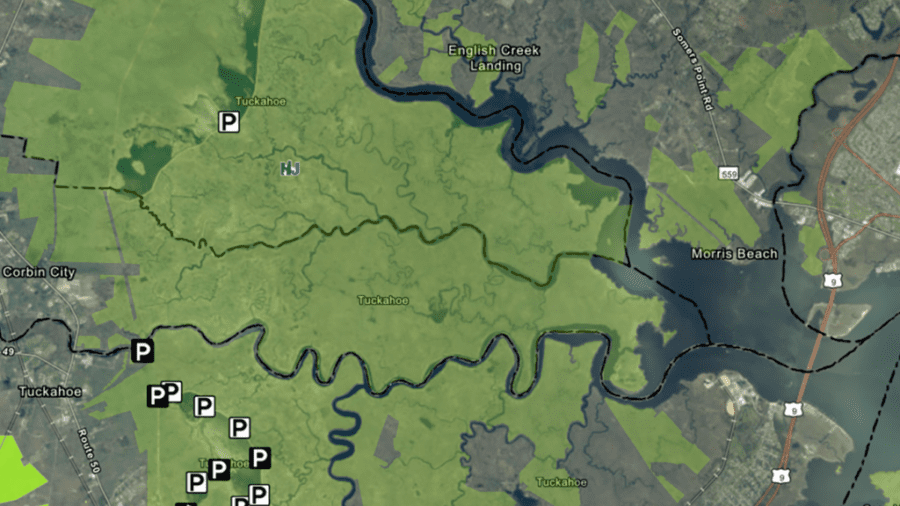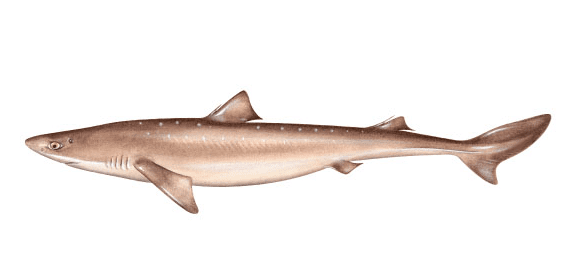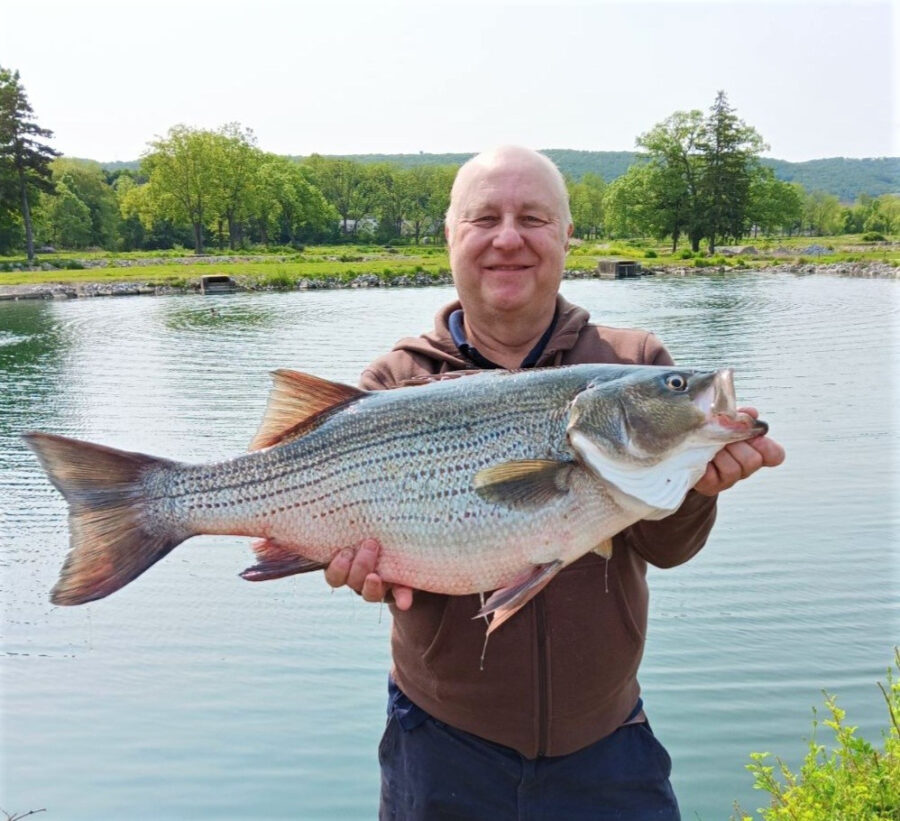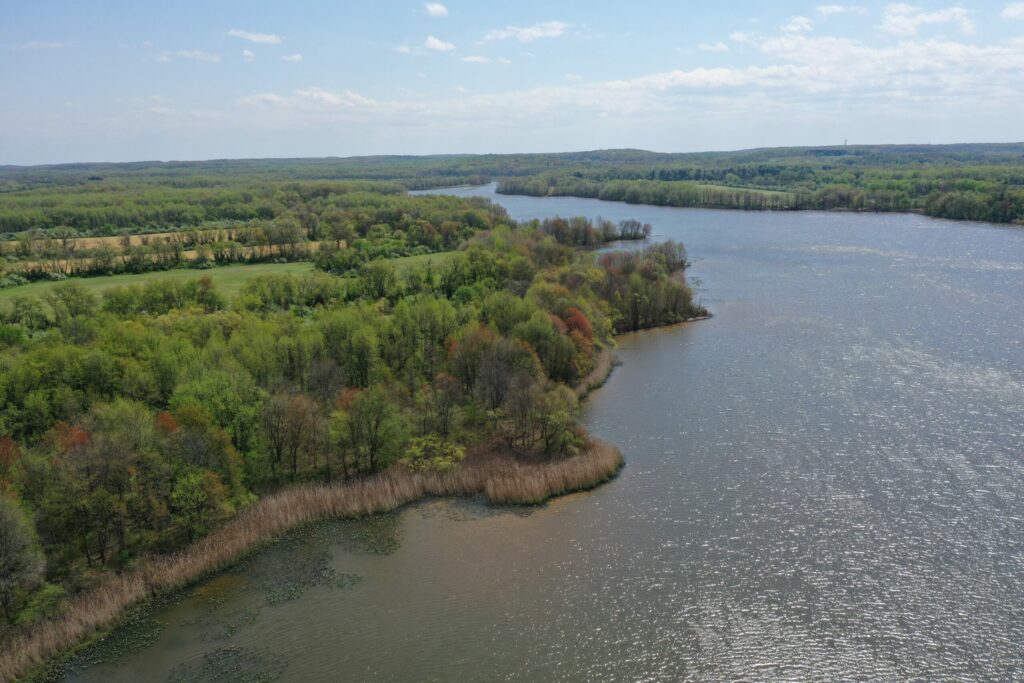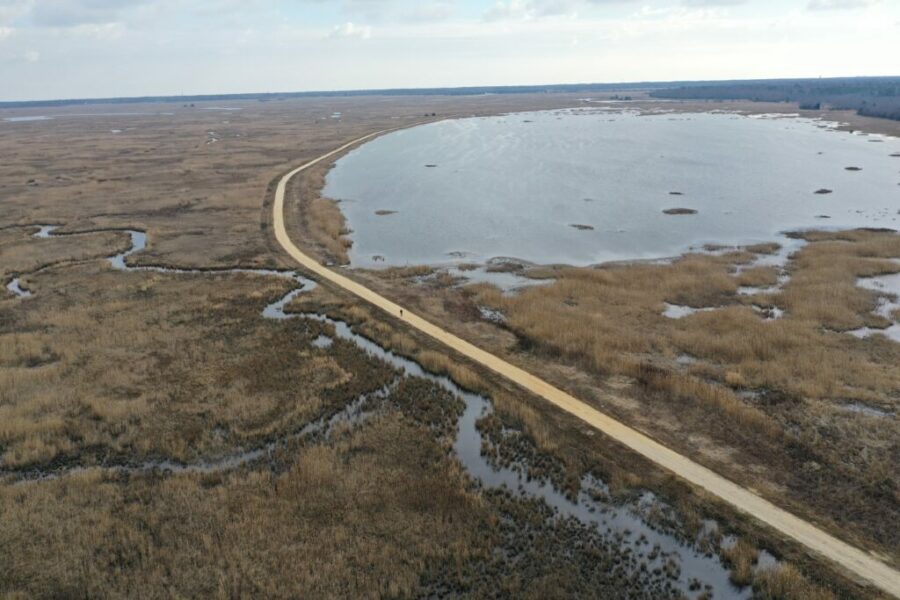


The Tuckahoe Wildlife Management Area located in Corbin City and Estelle Manor in Atlantic County, and Upper Township in Cape May County, is 18,785 acres of salt marsh, freshwater rivers, marshes, controlled impoundments, and Pine Barrens woodland. Tuckahoe WMA is one of the oldest areas owned by NJDEP Fish & Wildlife, with the initial purchase of 12,377 acres occurring in 1933.
This area, formerly known as Lester G. McNamara WMA, was dedicated to a former agency Director who established one set of impoundments in the 1940’s. These impoundments are still considered to be a great boon to waterfowl production, migration, and hunting. This extensive tract is located to the east of Route 50 with the Great Egg Harbor River forming its easternmost border. The scenic Tuckahoe River winds its way to its junction with the Great Egg Harbor through a breathtaking expanse of salt marsh. Located on the edge of the Pinelands, the uplands bordering the marsh typically reflect the pine-oak mixture of the outer coastal plain. Eight brackish water impoundments, a hardwood swamp, and a small freshwater lake provide diversity, making this wildlife management area a fabulous place to enjoy wildlife related recreation.
Wildlife Viewing
The diversity of habitats at Tuckahoe makes it an exciting location for watching wildlife. The Corbin City side of the tract offers an eight-mile drive on a dirt road traversing the dikes around the impoundments, then travels through a stretch of pine-oak uplands. Visitors can drive the entire route or park in the pull-offs and walk the unmarked trails between the impoundments. An observation platform located along the dikes makes a good vantage point for scanning the impoundments for wildlife. The dikes form the boundary between the impoundments and the salt marsh and with a turn of the head, one can view two entirely different ecosystems. Look for wading birds and rails along the creek banks. Occasionally, otters are seen cavorting along the banks or swimming in the creeks. If you walk quietly along the foot trails and search around the bottoms of the white cedar trees, you may find owl pellets left behind by long-eared owls. For those that enjoy walking, the Tuckahoe side of the tract offers miles of hiking along the old dike roads. The view here is the same with impoundments on one side, salt marsh on the other.
During spring and fall migration, the impoundments are teeming with shorebirds and waterfowl. Look for sandpipers, plovers, yellowlegs, knots, dunlin, dowitcher and turnstones feeding on the mudflats in the spring. Birders are often rewarded with a rare glimpse of the elusive American bittern. In the fall, the waterfowl migration is unsurpassed. Bald eagles nest nearby and can often be seen feeding in the impoundments or tidal creeks and golden eagles are frequent visitors in winter.
Fishing
Anglers enjoy fishing for largemouth bass, pickerel, yellow perch, sunfish and eels in the lake. There is also the unique opportunity to target Rainbow Trout during seasonal trout stockings in early spring. The rivers and bay offer up white perch, striped bass, fluke and flounder. Crabbing is also popular and productive. Fishing the river is difficult without a boat. Anglers occasionally fish from the bank at the boat ramp. You can park at either end of the dikes and walk the old road to fish or crab.
Boat Ramp
The boat ramp, located on Mosquito Landing Road, was upgraded in 2023 and improvements include a new concrete ramp, floating dock to tie up to pre/post launch, and a reconfigured parking lot. This ramp
provides access to the Tuckahoe River and consequently the Great Egg Harbor River and Bay. There is also a dirt ramp located at the end of Gibson Landing Road on the Corbin City side of the tract that provides access to the upper Great Egg Harbor River.
Waterfowl
Tuckahoe offers some of the finest waterfowl hunting in the state because it is attractive to so many different species such as black ducks, teal, wood ducks, mallards, snow geese and Canada geese. Pintails, shovelers, gadwall, widgeon and mergansers are also common. The impoundments at Tuckahoe and Corbin City were created in the 1940’s and 50’s to provide specific habitat for waterfowl; however, water level management allows biologists to maximize the availability of food for a variety of bird species.
The impoundments located on the Tuckahoe side of the WMA, are currently in year three of a managed waterfowl hunt pilot project. The goal of the project was to recruit, retain, and/or reactivate waterfowl hunters. This would be achieved by increasing satisfaction (number of birds seen/harvested), providing blinds and other equipment to give hunters an opportunity to try waterfowl hunting with little investment on their end, and be guaranteed a place to hunt. Blinds are selected via lottery, for which prospective hunters apply.
Upland Game
The upland game hunter will find hunting opportunities for rabbit, squirrel and woodcock. The agency stocks pheasants during the hunting season in fields along route 631 and in a large field on Gibson Creek Road. Prior to the small game season, game managers stock chukar in the dog training area located off Gibson Creek Road to give hunters an opportunity to work their dogs before the season. Management efforts focused on small game include activities like planting food and cover crops, mowing fields, and maintaining hedgerows.
Trapping
Tuckahoe offers excellent trapping opportunities for muskrat, mink, otter, beaver, and upland furbearers.
Deer and Turkey
This area has a deer herd and offers fair to marginal hunting on upland portions. Turkey are becoming more abundant and certain sections hold better flocks of birds.
Rangers
There is an archery range with three shooting lanes, and one is paved to accommodate archers with disabilities. Only field tips shall be used when shooting at the provided bag targets. If archers wish to practice using broadheads, they can do so but must bring their own target.
Restoration Project
A six-acre Atlantic White Cedar restoration project in the Tuckahoe WMA hosts an abundance of rare plants and animals, along with providing water pollutant filtration, flood protection, and carbon storage. Such stands of cedars are classified as a globally threatened ecosystem. The project has increased habitat diversity, ensuring native wildlife has habitat to thrive. It also provides increased recreational opportunities for outdoor enthusiasts.
Access
From the intersection of Route 40 and Route 50 in Mays Landing, continue South on Route 50. After 10.5 miles, turn left onto Griscom Mill Road. Continue for 0.3 miles to the entrance for Tuckahoe Wildlife Management Area.
Owned by New Jersey Department of Environmental Protection, Fish & Wildlife, the Wildlife Management Area System is comprised of more than 360,000 acres in 122 areas throughout the state, which is more than 44% of New Jersey’s state-owned public open space. WMAs are maintained and supported with funding from hunting and fishing license sales, the Federal Wildlife and Sport Fish Restoration Program and the Wildlife Habitat Supporter Program.
If you are interested in supporting the maintenance of Tuckahoe WMA and other Wildlife Management Areas, become a Wildlife Habitat Supporter by donating now:
WMAs are patrolled by NJ Fish & Wildlife Conservation Police Officers to ensure public safety. If you see violations while visiting a WMA, please call the 24-hour DEP hotline at 877-WARN-DEP (877-927-6337).
The views expressed by the editors, authors or users of this linked article are expressly theirs, and do not necessarily reflect the policies or opinions of Dallas Safari Club Northeast, its employees, members or assigns. Any concerns about a site user’s post should be addressed appropriately to that person. Any concerns about an advertiser, a user or any content on this site should be addressed to contact@dscnortheast.org.

